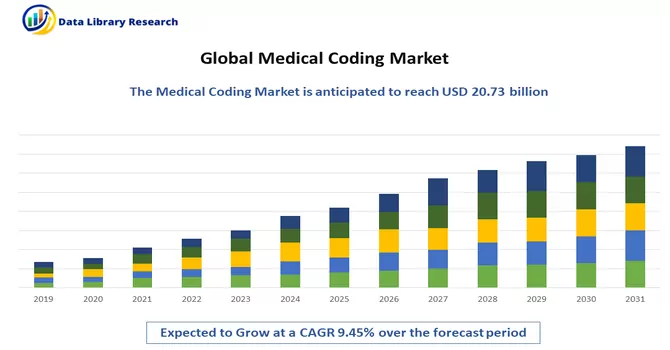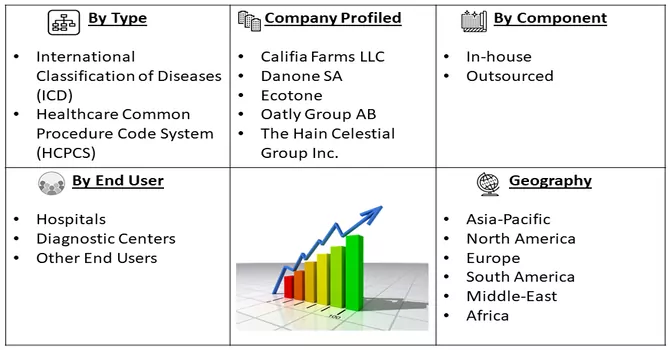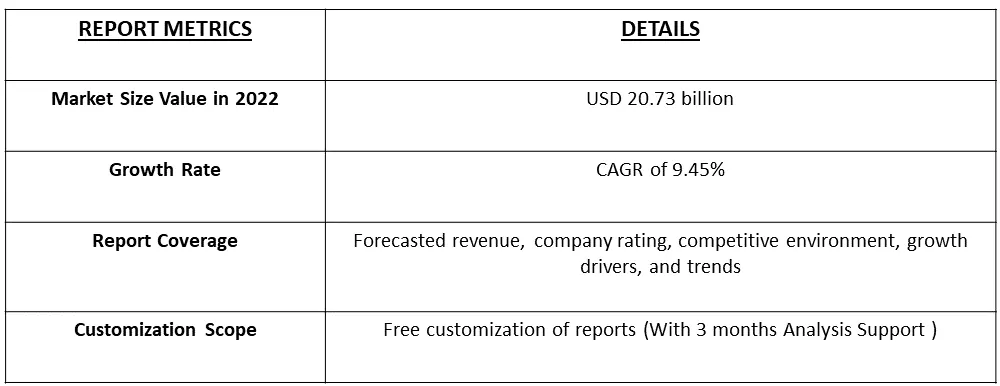The Medical Coding Market size is expected to grow from USD 20.73 billion in 2022, registering a CAGR of 9.45% during the forecast period (2023-2030).

Get Complete Analysis Of The Report - Download Free Sample PDF
Medical coding is the process of translating healthcare diagnoses, procedures, medical services, and equipment into universally recognized alphanumeric codes. These codes are used for various purposes, including billing and reimbursement, maintaining medical records, statistical analysis, and research in the healthcare industry. Medical coding ensures that healthcare providers, insurance companies, and government agencies can communicate and process healthcare information accurately and efficiently. There are several coding systems in use, with the most common ones being the International Classification of Diseases (ICD) for diagnoses and Current Procedural Terminology (CPT) for procedures in the United States.
The factors responsible for the growth of the market include the escalating demand for coding services, the rising need for a universal language to reduce frauds and misinterpretations associated with insurance claims, and the high demand for streamlining hospital billing procedures.
Market Segmentation:
The Global Medical Coding Market is Segmented
By Classification System :
Component :
End User :
Geography :

For Detailed Market Segmentation - Download Free Sample PDF
Medical coding is a crucial component of the healthcare industry, providing a standardized system for documenting and classifying medical diagnoses and procedures. It plays a significant role in billing, reimbursement, compliance, and data analysis. The field of medical coding is continually evolving to adapt to changing healthcare practices, regulations, and technological advancements. AI and automation are being integrated into medical coding processes. These technologies assist coders by suggesting codes based on clinical documentation, reducing the potential for errors and streamlining the coding process.
Drivers:
Rising Need for a Universal Language to Reduce Frauds and Misinterpretations Associated with Insurance Claims
The rising need for a universal language in healthcare coding is driven by the desire to reduce fraud, errors, and misinterpretations associated with insurance claims and medical coding. Establishing such a standard is a complex and ongoing process, but it holds the potential to greatly enhance the efficiency, accuracy, and integrity of healthcare operations, ultimately benefiting patients, healthcare providers, and insurance companies alike. Accurate and consistent coding is essential for maintaining high-quality healthcare data. A universal coding language can improve data accuracy, making it easier to analyze healthcare trends, outcomes, and costs. Thus, the market is expected to witness significant growth over the forecast period.
Escalating Demand for Coding Services and High Demand to Streamline Hospital Billing Procedures The escalating demand for coding services and the push to streamline hospital billing procedures and medical coding reflect the evolving landscape of the healthcare industry. Healthcare facilities and providers are increasingly recognizing the significance of accurate and efficient coding services, not only for financial reasons but also for delivering better patient care and fostering data-driven healthcare practices. The demand for coding services is expected to continue growing as the healthcare sector embraces technology and strives for enhanced efficiency and accuracy. Streamlining billing procedures often goes hand-in-hand with ensuring compliance with healthcare regulations. This not only avoids penalties but also maintains the reputation and trust of patients and partners. Error reduction is a key motivation for streamlining billing procedures. Inaccurate coding can result in claim denials, compliance issues, and revenue loss. Thus, the due the above-mentioned reasons the market is expected to witness significant growth over the forecast period.
Restraints :
Changing Regulations Related to Medical Coding
The medical coding market is facing a set of challenges stemming from the continuously evolving landscape of healthcare regulations. These changing regulations are having a significant impact on medical coding processes and are impeding the growth of the market. Moreover, regulations can change frequently. For instance, the ICD (International Classification of Diseases) coding system is updated regularly. Medical coders need to adapt to these updates promptly, which can be challenging. Thus, the growth of the market is expected slowed down over the forecast period.
The global healthcare system underwent a significant transformation due to the COVID-19 pandemic. The World Health Organization (WHO) took swift actions to address this health crisis. In February 2020, emergency codes were activated to categorize confirmed COVID-19 diagnoses and suspected or probable cases. Additionally, in April 2020, the WHO published international guidelines in seven languages for certifying and classifying COVID-19 as the cause of death. Furthermore, the Centers for Medicare and Medicaid Services (CMS) played a pivotal role in assisting healthcare providers in managing the medical billing and coding aspects of COVID-19 testing and treatment. For example, in March 2020, CMS released two Healthcare Common Procedure Coding System (HCPCS) codes, which laboratories could utilize to bill for specific COVID-19 diagnostic tests, including those developed in-house in accordance with the new United States Food and Drug Administration (USFDA) guidelines. The ramifications of the COVID-19 outbreak were profound, leading to various changes in the studied market. These changes are expected to leave a lasting impact, influencing the market's trajectory in the long term. Consequently, the market is anticipated to regain its momentum in the years to come.
Segmental Analysis :
International Classification of Diseases (ICD) Segment is Expected to Witness Significant Growth Over the Forecast Period
The International Classification of Diseases (ICD) is a cornerstone of healthcare, offering a standardized and comprehensive framework for classifying and coding health conditions. Its use in medical coding is critical for accurate diagnostic and procedural coding, insurance claims, research, and public health analysis. The ICD's universal language plays a pivotal role in enhancing the quality of patient care, advancing medical research, and supporting international collaboration in healthcare. Governments and health agencies use the ICD to monitor and respond to disease outbreaks and public health emergencies. The ICD's standardized coding system assists in the rapid identification and tracking of diseases. Thus, owing to such advantages, the segment is expected to witness significant growth over the forecast period.
Outsourced Segment is Expected to Witness Significant Growth Over the Forecast Period
Outsourcing to specialized medical coding companies or professionals often means tapping into a pool of experienced and certified coders. This expertise leads to accurate coding, reducing the risk of errors and claim denials. Outsourced coding services can be scaled up or down to match the fluctuating demands of healthcare organizations. This flexibility is especially beneficial for smaller practices or facilities with variable workloads. Outsourced medical coding is a viable solution for healthcare organizations seeking to streamline their coding processes, reduce costs, and improve accuracy. However, careful consideration of the outsourcing partner, data security, regulatory compliance, and ongoing communication is essential to ensure a successful and beneficial arrangement. Thus segment is expected to witness significant growth over the forecast period.
Hospital Segment is Expected to Witness Significant Growth Over the Forecast Period
Hospitals rely on medical coding to bill for the services they provide. Accurate coding is essential to ensure that hospitals are properly reimbursed by insurance companies and government healthcare programs such as Medicare and Medicaid. Moreover, hospitals rely on coded data to analyze clinical outcomes, patient demographics, disease prevalence, and resource allocation. This data is instrumental in making informed decisions for quality improvement and resource optimization. Thus, the segment is expected to witness significant growth over the forecast period.
North America is Expected to Witness Significant Growth Over the Forecast Period
The medical coding market in North America is poised to capture a substantial share throughout the forecast period, primarily due to remarkable technological advancements and the enhancement of healthcare infrastructure across various countries in the region. The increasing demand for coding services, coupled with a high requirement for streamlining hospital billing procedures, driven by the rising prevalence of chronic diseases, is further bolstering market growth in this region. The escalating burden of chronic diseases in different North American countries is a significant contributor to the market's expansion. For instance, the American Cancer Society projects a staggering 1,918,030 new cases of cancer in the United States for 2022. This surge in disease cases necessitates more efficient hospital billing procedures, thereby stimulating market growth.
Additionally, strategic initiatives undertaken by key market players are playing a pivotal role in propelling market growth. An illustrative example of this is WELL Health Technologies Corp., a Canadian organization, which, in October 2022, inked an agreement to acquire Cloud Practice Inc. and three clinics from CloudMD Software & Services Inc. Furthermore, in the same month, RBC acquired MDBilling.ca, a cloud-based platform that simplifies and automates medical billing for Canadian physicians. In light of these compelling factors, the medical coding market in North America is poised for substantial growth throughout the forecast period.

Get Complete Analysis Of The Report - Download Free Sample PDF
The medical coding market is moderately competitive due to the presence of many local and international providers offering a wide array of services. All the players are adopting various growth strategies to enhance their market presence. Some of the key players in the market studied are:
Key Players :
Recent Developments :
1. April 2022: Ochsner Health's emergency department adopted Nym health's medical coding technology to empower revenue cycle management.
2. April 2022: XpertDox entered into an exclusive partnership with Urgent Care for Children USA (UC4C) to provide XpertCoding. It is a fully automated, turnkey solution that delivers medical coding efficiency and accelerates the revenue cycle across all of UC4C's clinics in Alabama and Tennessee.
Q1. What was the Medical Coding Market size in 2022?
As per Data Library Research The Medical Coding Market size is valued at USD 20.73 billion.
Q2. At what CAGR is the market projected to grow within the forecast period?
Medical Coding Market is registering a CAGR of 9.45% during the forecast period.
Q3. Which region has the largest share of the Medical Coding Market? What are the largest region's market size and growth rate?
North America has the largest share of the market. For detailed insights on the largest region's market size and growth rate request a sample here
Q4. What segments are covered in the Medical Coding Market Report?
By Classification System, By Component, End- User and Geography these segments are covered in the Medical Coding Market Report.
Data Library Research are conducted by industry experts who offer insight on industry structure, market segmentations technology assessment and competitive landscape (CL), and penetration, as well as on emerging trends. Their analysis is based on primary interviews (~ 80%) and secondary research (~ 20%) as well as years of professional expertise in their respective industries. Adding to this, by analysing historical trends and current market positions, our analysts predict where the market will be headed for the next five years. Furthermore, the varying trends of segment & categories geographically presented are also studied and the estimated based on the primary & secondary research.
In this particular report from the supply side Data Library Research has conducted primary surveys (interviews) with the key level executives (VP, CEO’s, Marketing Director, Business Development Manager and SOFT) of the companies that active & prominent as well as the midsized organization
FIGURE 1: DLR RESEARH PROCESS

Extensive primary research was conducted to gain a deeper insight of the market and industry performance. The analysis is based on both primary and secondary research as well as years of professional expertise in the respective industries.
In addition to analysing current and historical trends, our analysts predict where the market is headed over the next five years.
It varies by segment for these categories geographically presented in the list of market tables. Speaking about this particular report we have conducted primary surveys (interviews) with the key level executives (VP, CEO’s, Marketing Director, Business Development Manager and many more) of the major players active in the market.
Secondary ResearchSecondary research was mainly used to collect and identify information useful for the extensive, technical, market-oriented, and Friend’s study of the Global Extra Neutral Alcohol. It was also used to obtain key information about major players, market classification and segmentation according to the industry trends, geographical markets, and developments related to the market and technology perspectives. For this study, analysts have gathered information from various credible sources, such as annual reports, sec filings, journals, white papers, SOFT presentations, and company web sites.
Market Size EstimationBoth, top-down and bottom-up approaches were used to estimate and validate the size of the Global market and to estimate the size of various other dependent submarkets in the overall Extra Neutral Alcohol. The key players in the market were identified through secondary research and their market contributions in the respective geographies were determined through primary and secondary research.
Forecast Model
